Black-shouldered kite
| Black-shouldered kite | |
|---|---|
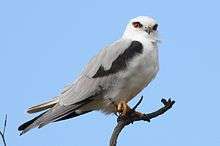 | |
| At Royal Botanic Gardens, Cranbourne, Melbourne, Victoria, Australia | |
| Scientific classification | |
| Kingdom: | Animalia |
| Phylum: | Chordata |
| Class: | Aves |
| Order: | Accipitriformes |
| Family: | Accipitridae |
| Genus: | Elanus |
| Species: | E. axillaris |
| Binomial name | |
| Elanus axillaris (Latham, 1801) | |
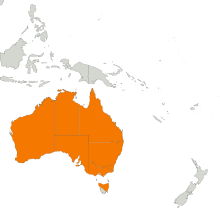 | |
| Range of E. axillaris | |
The black-shouldered kite (Elanus axillaris), Australian black-shouldered kite, or simply Australian kite, is a small raptor found in open habitat throughout Australia. It resembles similar species found in Africa, Eurasia and North America, including the black-winged kite, a species that has in the past also been called "black-shouldered kite".
Measuring 35–38 cm (14–15 in) in length with a wingspan of 80–95 cm (31–37 in), the adult black-shouldered kite is a small and graceful raptor with red eyes. Their primary call is a clear whistle, uttered in flight and while hovering.
Black-shouldered kites form monogamous pairs, breeding between August and January. The birds engage in aerial courtship displays which involve high circling flight and ritualised feeding mid-air. Three or four eggs are laid and incubated for around thirty days. Chicks are fully fledged within five weeks of hatching and can hunt for mice within a week of leaving the nest. Juveniles disperse widely from the home territory.
Taxonomy
The black-shouldered kite was first described by English ornithologist John Latham in 1801, as Falco axillaris.[2][3] Its specific name is derived from the Latin axilla, meaning "armpit".[4]
The name "black-shouldered kite" was formerly used for a Eurasian and African species, Elanus caeruleus, with the Australian species, Elanus axillaris, and the North American species, the white-tailed kite Elanus leucurus, treated as subspecies of this. These three Elanus species have comparable plumage patterns and sizes, however, they are now regarded as distinct, and the name black-winged kite is used for E. caeruleus. Modern references to the black-shouldered kite should therefore unambiguously mean the Australian species, E. axillaris.[5] The Australian black-shouldered kite was formerly called E. notatus, but it was not clear that the name applied to this species alone.[6]
In 1851, British zoologist Edward Blyth described Elaninae, the "smooth clawed kites" as a formal subfamily of Accipitridae.[7] However, they are also grouped in Accipitrinae, the broader subfamily of hawks and eagles described by French ornithologist Louis Jean Pierre Vieillot in 1816.[8]
A taxonomic proposal based on DNA studies has recommended classifying Elanus kites as a separate family (Elanidae).[9] A 2004 molecular study of cytochrome-b DNA sequences shows them to have split off from typical hawks and eagles at an earlier date than the Osprey, which has been classified in its own family.[10]
Description
Appearance
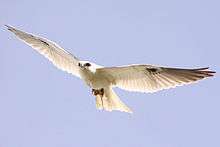
Black-shouldered kites are around 35 to 38 cm (14 to 15 in) in length and have a wingspan of between 80 and 95 cm (31 and 37 in) and an average weight of 291 g (10.3 oz). Adults are a pale grey with a white head and white underparts. The leading edge of the inner wing is black. When perched, this gives them their prominent black "shoulders". Like related species they feature bright red eyes, set in a black comma-shaped marking. They have a squared tail and a streamlined aerodynamic body. The bill is short with a sharp, hooked tip to the upper mandible. Their nostrils and the cere are bright yellow and the bill is black. The legs and feet are also yellow, and the feet have three toes facing forwards and one toe facing backwards.[11] The sexes are similar, with females only just larger than males, although they can be up to 15% heavier.[12]
The juveniles’ markings follow a similar pattern to adult birds, but they are washed with a rusty brown on the head and upper breast, and the back and wings are mottled buff or brown with prominent white tips. The young birds’ eyes are brown.[12]
The black-shouldered kite is very similar to the related raptor species, the letter-winged kite (E. scriptus) but has the black mark above and behind the eye, a white rather than grey crown, and shows all-white underparts in flight except for the black patch at the shoulder and dark wingtips.[13]
Vocalizations
Black-shouldered kites are generally silent, except in the breeding season when their calls, though weak, can be persistent.[12] They primarily utter clear whistled 'chee, chee, chee' calls in flight and while hovering, or a hoarse wheezing 'skree-ah' when perched.[12] The call has been confused with that of a silver gull.[14] A short high whistle is the primary contact call between a pair, while a harsh scraping call is the most common call used by females and large young, and brooding females call to their young with a deep, soft, frog-like croak.[15]
A variety of different calls have been recorded from captive birds, including harsh, harmonic, chatter and whistle vocalisations. Harsh calls were made when a bird was alarmed or agitated, whistle-type calls were emitted in general contexts, sometimes monotonously, and shorter duration 'chatter' calls were given when a bird sighted a human near the enclosure.[16]
Distribution and habitat
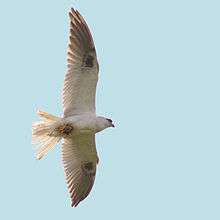
Australian kites may be sedentary or nomadic, and generally occur in open grasslands or valleys where there are scattered clumps of trees. In urban areas they are found on the edge of towns on wasteland, irregularly mown areas, or grassy roadside verges.[11] They also hunt over coastal dunes, drier marshland, and farmland.[12]
Their numbers fluctuate during drought and floods, and can be irruptive in response to sudden increases in mouse populations.[12] The most distant banding recovery was from South Australia to eastern New South Wales, a distance of 1,000 km (620 mi).
Although reported throughout Australia, they are most common in the relatively fertile south-east and south-west corners of the mainland, and in south-east Queensland. They are rare in the deep desert and are only occasional visitors to northern Tasmania and the Torres Strait islands. As the species has a large range and an increasing population, it has been listed as "Least Concern" on the IUCN Red List of Threatened species.[1][17] In southwestern Australia, they are now one of the most commonly recorded raptors in the wheatbelt.[6]
European occupation of Australia has, on the whole, benefited black-shouldered kites through land clearing and irrigation for agriculture and grain harvesting and storage practices which provide suitable conditions for much larger numbers of mice.[11] According to raptor researcher Dr Stephen Debus, this species did not suffer from eggshell thinning during the period of DDT use in Australia, though he believes it is possible that secondary poisoning may occur from rodenticides used during mouse plagues or from pesticides used during locust plagues.[6] Populations in areas with high sheep and rabbit numbers may decline, as these animals compact the soil and reduce the available habitat for mice.[11]
Behaviour
Sociality

Black-shouldered kites usually hunt singly or in pairs, though where food is plentiful they occur in small family groups and can be loosely gregarious at times of irruptions, with up to 70 birds reported feeding together during a mouse plague.[12] They roost communally, like other Elanus species.[6]
They are territorial when food is not abundant. The practice of "tail flicking" where, on landing, the tail is flicked up and lowered and the movement repeated persistently is thought to be a possible territorial display.[12] Black-shouldered kites have been observed in aerial combat at the margins of territories, locking talons in a behaviour described as "grappling".[18]
Food and hunting
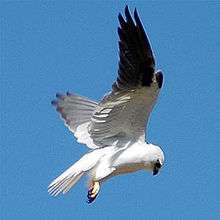
Black-shouldered kites live almost exclusively on mice, and have become a specialist predator of house mice, often following outbreaks of mouse plagues in rural areas.[19] They take other suitably sized creatures when available, including grasshoppers, rats, small reptiles, birds, and even (very rarely) rabbits, but mice and other mouse-sized mammals account for over 90% of their diet. Their influence on mouse populations is probably significant: adults take two or three mice a day each if they can,[19] around a thousand mice a year.[15] On one occasion, a male was observed bringing no less than 14 mice to a nest of well-advanced fledglings within an hour.[20] In another study, a female kite was seen to struggle back to fledglings in the nest with a three-quarters grown rabbit, a heavy load for such a small bird.[21]
Like other elanid kites, black-shouldered kites hunt by quartering grasslands for small creatures. This can be from a perch, but more often by hovering in mid-air.[12] When hunting the kite hovers with its body hanging almost vertically, and its head into the wind.[21] Unlike the Australian kestrel, the black-winged kite shows no obvious sideways movement, even in a strong breeze.[21] One study of a nesting pair noted that the male searched aerially for 82% of the search time.[20] Typically, a kite will hover 10 to 12 m (33 to 39 ft) above a particular spot, peering down intently, sometimes for only a few seconds, often for a minute or more, then glide swiftly to a new vantage point and hover again.[22] When hunting from a perch, a dead tree is the preferred platform. Like other Elanus kites, The black-shouldered kite grips a vertical branch with a foot on either side, each one above the other and turned inwards, which enables them to maintain a secure footing on relatively small branches.[15] Though hovering is the most common hunting method, the kites have been observed searching the ground beneath a vantage point for periods of up to an hour.[15]
When a mouse or other prey is spotted, the kite drops silently onto it, feet-first with wings raised high; sometimes in one long drop to ground level, more often in two or more stages, with hovering pauses at intermediate heights. Prey is seized in the talons and about 75% of attacks are successful.[20] Prey can either be eaten in flight or carried back to a perch. Birds will have a favoured feeding perch, beneath which accumulate piles of pellets or castings.[22]
They are diurnal, preferring to hunt during the day, particularly in the early morning and mid to late afternoon, and will occasionally hunt in pairs. Their hunting patterns, outside breeding periods and periods of abundant prey, have distinct crepuscular peaks, perhaps corresponding to mouse activity.[22]
Flight
Black-shouldered kites spiral into the wind like a kestrel. They soar with v-shaped up-curved wings, the primaries slightly spread and the tail widely fanned.[13] In level flight progress is rather indirect.[22] Their flight pattern has been described as 'winnowing' with soft steady beats interspersed with long glides on angled wings.[12] They can most often be seen hovering with wings curved and tail pointing down.
Breeding
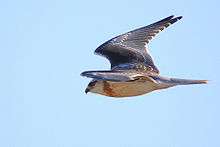

Aerial courtship displays involve single and mutual high circling flight, and the male may fly around slowly with stiff exaggerated flaps, commonly known as butterfly-flight.[23] Courting males dive at the female, feeding her in mid-flight. The female grabs food from the male's talons with hers while flipping upside-down. They may lock talons and tumble downwards in a ritualised version of grappling, but release just before landing.[24] All courtship displays are accompanied by constant calling.[12]
Black-shouldered kites form monogamous pairs. The breeding season is usually August to January, but is responsive to mice populations,[12] and some pairs breed twice in a good season.[25] Both sexes are involved in building the nest, which is a large untidy shallow cup of sticks usually in the foliage near the top of trees, taking about two weeks to complete the nest-building.[15] The flat nest is built of thin twigs and is around 28 to 38 cm (11 to 15 in) across when newly built, but growing to around 78 cm (31 in) across and 58 cm (23 in) deep after repeated use.[12] The nest is lined with green leaves and felted fur, though linings of grass and cow dung have also been reported.[12] It is generally located in the canopy of an isolated or exposed tree in open country, elevated 5 to 20 m (16 to 66 ft) or more above the ground. Black-shouldered kites have been known to use old Australian magpie, crow or raven nests.[26]
Females perform most of the care of eggs and nestlings, though males take a minor share of incubation and brooding.[20] The clutch consists of three to four dull white eggs of a tapered oval shape measuring 42 mm × 31 mm (1.7 in × 1.2 in) and with red-brown blotches that are often heavier around the larger end of the egg.[26] The female incubates the eggs for 30 days and when the eggs hatch the chicks are helpless but have soft down covering their body. For the first two weeks or so the female broods the chicks constantly, both day and night. The female does no hunting at all for the first three weeks after hatching, but calls to the male from the nest, and he generally responds by bringing food.[21] The female feeds the chicks with the mice brought back to the nest by the male,[11] feeding them in tiny pieces for the first week or two, at which time the chicks are capable of swallowing a mouse whole.[21] The nestling period lasts around 36 days, and the post-fledging period at least 36 days with parental feeding for at least 22 days.[20] When the chicks are older both parents take it in turns to feed them. Black feathers start to appear along the chicks' wings when they are about a fortnight old, and they are fully fledged and are ready to fly in five weeks.[11] Within a week of leaving the nest the young birds are capable of hunting for mice on their own.[15]
Juveniles disperse widely, taking up territory that can be as far as 1,000 km (620 mi) from the nest site.[25]
References
- 1 2 BirdLife International (2012). "Elanus axillaris". IUCN Red List of Threatened Species. Version 2013.2. International Union for Conservation of Nature. Retrieved 26 November 2013.
- ↑ Latham, John (1801). Supplementum indicis ornithologici sive systematis ornithologiae (in Latin). London: Leigh & Sotheby. p. ix.
- ↑ Penhallurick, J.M. (1982). "Review of Nocturnal Birds of Australia by R. Schodde & I. J. Mason" (PDF). Emu. 82: 183.
- ↑ Jobling, James A (2010). The Helm Dictionary of Scientific Bird Names. London: Christopher Helm. p. 63. ISBN 978-1-4081-2501-4.
- ↑ Negro, Juan J.; Pertoldi, Cino; Randi, Ettore; Ferrero, Juan J.; López-Caballero, José M.; Rivera, Domingo; Korpimäki, Erkki (2006). Boal, Clint, ed. "Convergent Evolution of Elanus Kites and the Owls". Journal of Raptor Research. Raptor Research Foundation. 40 (3): 222–225. doi:10.3356/0892-1016(2006)40[222:CEOEKA]2.0.CO;2. ISSN 0892-1016.
- 1 2 3 4 Global Raptor Information Network (1999). "Australian Kite Elanus axillaris". Species account. GRIN. Retrieved 9 May 2010.
- ↑ "The Taxonomicon Taxon Tree". Retrieved 30 May 2010.
- ↑ "The Taxonomicon". Retrieved 30 May 2010.
- ↑ Debus, Stephen (June 2004). "Australian Raptors: The Big Picture" (PDF). Boobook. The Australian Raptor Association. 22 (1): 4–5.
- ↑ Wink, M.; Sauer-Gürth, H. (2004). "Phylogenetic relationships in diurnal raptors based on nucleotide sequences of mitochondrial and nuclear marker genes". In Chancelor, R.D.; Meyburg, B-U. Raptors Worldwide (PDF). Berlin: WWGBP. pp. 483–98. Retrieved 11 May 2010.
- 1 2 3 4 5 6 "Black-shouldered Kite". Birds in Backyards. Birds Australia, Australian Museum. 19 February 2007. Retrieved 8 May 2010.
- 1 2 3 4 5 6 7 8 9 10 11 12 13 14 Ferguson-Lees, James; Christie, David A. (2001). Raptors of the World. illustrated by Kim Franklin, David Mead, and Philip Burton. London, UK: Christopher Helm. pp. 359–360. ISBN 0-7136-8026-1.
- 1 2 Morcombe, Michael (2000). Field Guide to Australian Birds. Queensland, Australia: Steve Parish Publishing. pp. 88–89. ISBN 1-876282-10-X.
- ↑ Wade, P., ed. (1977). Every Australian Bird Illustrated. Rigby. ISBN 0-7270-0009-8.
- 1 2 3 4 5 6 Hollands, D. (1984). Eagles, Hawks and Falcons of Australia. Melbourne, Australia: Thomas Nelson. ISBN 0-17-006411-5.
- ↑ Jurisevic, Mark A. (1998). "Comparison of Vocalisations of Australian Falcons and Elanine Kites". Emu. Collingwood, Victoria: Royal Australasian Ornithologists Union. 98 (1): 1–12. doi:10.1071/MU98001.
- ↑ "Species factsheet: Black-shouldered Kite (Elanus axillaris)". birdlife.org. BirdLife International. Retrieved 6 June 2009.
- ↑ Whitt, Michael (1992). "Grappling in Black-shouldered Kites". Western Birds. Western Field Ornithologists. 23 (2): 81–83.
- 1 2 Sinclair, A.R.E.; Olsen, Penny D.; Redhead, T.D. (1990). "Can Predators Regulate Small Mammal Populations? Evidence from House Mouse Outbreaks in Australia". Oikos. Blackwell Publishing on behalf of Nordic Society Oikos. 59 (3): 382–392. doi:10.2307/3545150. JSTOR 3545150.
- 1 2 3 4 5 Debus, S.J.S.; Olde, G.S.; Marshall, N.; Meyer, J.; Rose, A.B. (September 2006). "Foraging, Breeding Behaviour and Diet of a Family of Black-shouldered Kites Elanus axillaris near Tamworth, New South Wales". Australian Field Ornithology. 23 (3): 130–143.
- 1 2 3 4 5 Cupper, Jack; Cupper, Lindsay (1981). Hawks in Focus : A Study of Australia's Birds of Prey. Mildura, Australia: Jaclin Enterprises. p. 7. ISBN 0-9593975-0-7.
- 1 2 3 4 Morris, Frank T. (1976). Birds of Prey of Australia. Melbourne, Australia: Lansdowne Press. pp. 78–79. ISBN 0-7018-1001-7.
- ↑ Chan, Melinda (11 April 2007). "Black-shouldered Kites at play". Bird Ecology Study Group. Retrieved 21 March 2015.
- ↑ Curtis, Lee K.; Rowland, Peter (Winter 2008). "Australian Kites" (PDF). Wildlife Australia Magazine: 40–41.
- 1 2 Debus, Stephen (1998). The birds of prey of Australia: a field guide. Melbourne, Australia: Oxford University Press. ISBN 0-19-550624-3.
- 1 2 Beruldsen, Gordon (2003). Australian Birds: Their Nests and Eggs. Kenmore Hills, Queensland: self. p. 198. ISBN 0-646-42798-9.
External links
| Wikimedia Commons has media related to Elanus axillaris. |
| Wikispecies has information related to: Elanus axillaris |
- Black-shouldered Kite Species text in The Atlas of Southern African Birds
- BirdLife species factsheet for Elanus axillaris
- "Elanus axillaris". Avibase.

- "Australian Black-shouldered Kite media". Internet Bird Collection.
- Interactive range map of Elanus axillaris at IUCN Red List maps
- Audio recordings of Black-shouldered kite on Xeno-canto.
